A method to improve PUF reliability in FPGAs
2018-04-12LiangHuaguoLiWeidiXuXiuminWangHaoyu
Liang Huaguo Li Weidi Xu Xiumin Wang Haoyu
(School of Electronic Science and Applied Physics, Hefei University of Technology, Hefei 230000, China)
With the rapid development of information technology, hardware security and credibility, which act as an important part in information security, have attracted significant attention.The physical unclonable function (PUF)[1-2], an emerging cryptographic primitive[3]using intrinsic integrate circuits (IC)to manufacture variables, presents a promising solution for low-cost device authentication and secure key generation.Different from traditional cryptography methods, PUFs extract signatures from complex inherent properties of physical materials rather than storing them in a non-volatile memory.Consequently, the keys generated by the PUF offer the advantages of low cost, volatility, unpredictability and a simple structure.Thus, it serves as an excellent solution for security related applications, such as chip encryption, key storage[4], authentication, FPGA intellectual property (IP)protection and ID generation[1-2,5-6].
Once the PUF is implemented with a nominally symmetric layout, the random mismatches induced by the manufacturing process determine the PUF outputs.However, when the fluctuation caused by the operating conditions is greater than or close to the mismatches, the outputs are likely to change constantly, i.e., poor reliability[7].The conventional method used to improve PUF reliability is based on the use of error correction codes (ECC), while the approach significantly increases the complexity and cost of the design.Furthermore, the correcting code could reveal some important information.Another widely used method is mismatch selection, for instance, adjusting ring oscillator (RO)configuration to select the maximum frequency difference between two ROs with the same layout.Another common approach is to detect the bit-flipping situation of PUF responses by changing the operating conditions (voltage, temperature, aging, etc).However, this approach faces two main issues: 1)It needs to increase additional resources which consist of special voltage regulator circuits and temperature box equipment, etc.2)It will be time-consuming due to the need for tuning operating conditions.To deal with these problems, we propose an effective test approach in FPGAs, utilizing the effect of different complexity of surrounding logic on PUF outputs to discard slices with bit-flipping (unreliable slices)and thus improve PUF reliability.This is achieved by mapping PUFs to cells which are highly reliable.
1 Related Works
Since Gassend et al.[1]proposed silicon PUF for the first time, researchers began to consider the factors affecting PUF reliability.They demonstrated that PUF is susceptible to environmental variations such as temperature, silicon aging[8], voltage[9], and the surrounding logic[10], which make it difficult to produce correct PUF responses.
To increase PUF robustness against environmental variations, one method is to choose the pairs only with large differences in initial frequencies[2].However, the approach mainly faces an issue of high hardware resource overheads.In Ref.[11], data evaluation results show a reliability of 98.3% over the temperature range of 0 to 120 ℃ and 10% fluctuations in the supply voltage.As noted in Ref.[12], to improve PUF reliability, a configurable RO design was proposed, but the configurable oscillator design needs to add other gate units and multiplexers.In Ref.[13], a hybrid RO PUF with improved response stability was presented.Ref.[9] proposed an aging-resistant design which has 3.8% bits of PUF flip over a ten-year operational period due to the aging effect, compared with the conventional RO-PUF.
2 Design and Implementation of PUF
2.1 Ring oscillator PUFs
The proposed RO-PUF structure is shown in Fig.1.The frequency of ring oscillators, composed of an odd number of inverters and some delay components, depends on manufacturing variations.Assuming that the two ROs generate periodical signals with the frequency offiandfj(i≠j), a final relative comparison of the counter values generates a logical 0 or 1 for this RO pair:
wherefiandfjare the frequencies of thei-th RO (ROi)and thej-th RO (ROj), respectively.
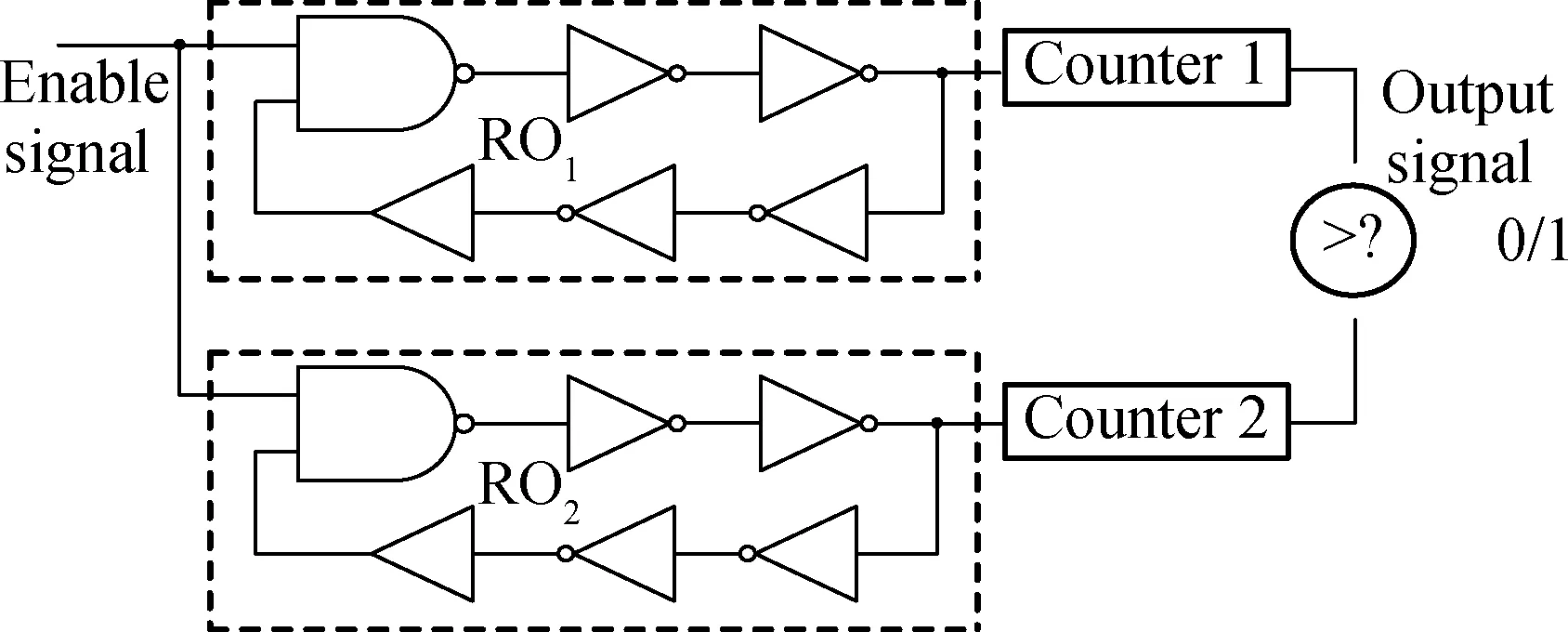
Fig.1 RO-PUF structure
2.2 Hard macro design
In our design, the RO-PUFs are implemented on Xilinx Virtex-6 FPGA boards.Each RO consists of four inverters, an NAND gate and a buffer as shown in Fig.2.Four inverters are implemented in a single slice.An NAND gate and a buffer are implemented in a single slice.Fig.2 shows two nearly identical RO1and RO2, implemented in four slices (slice_XiYj, slice_Xi+2Yj, slice_XiYj+1and slice_Xi+2Yj+1), the basic division of a Xilinx FPGA.Each slice contains four logic-function generators (or look-up tables).Fig.2 also exhibits the result of estimated delay information between interconnections and gates provided by the Xilinx FPGA Editor.
The configurable logic blocks (CLBs)are the main logic resources for implementing sequential and combinational circuits.Fig.3 shows that a hard macro with local routing for four inverters implemented in slice are completely identical with respect to placement and routing.A CLB element contains one pair of slices.To ensure identical routing for all RO instances, the locations of LUTs and the measurement flip-flops are manually specified using relative location constraint, so that the identical placement of all PUFs can be achieved, which helps increase the uniqueness and randomness of the PUF outputs.
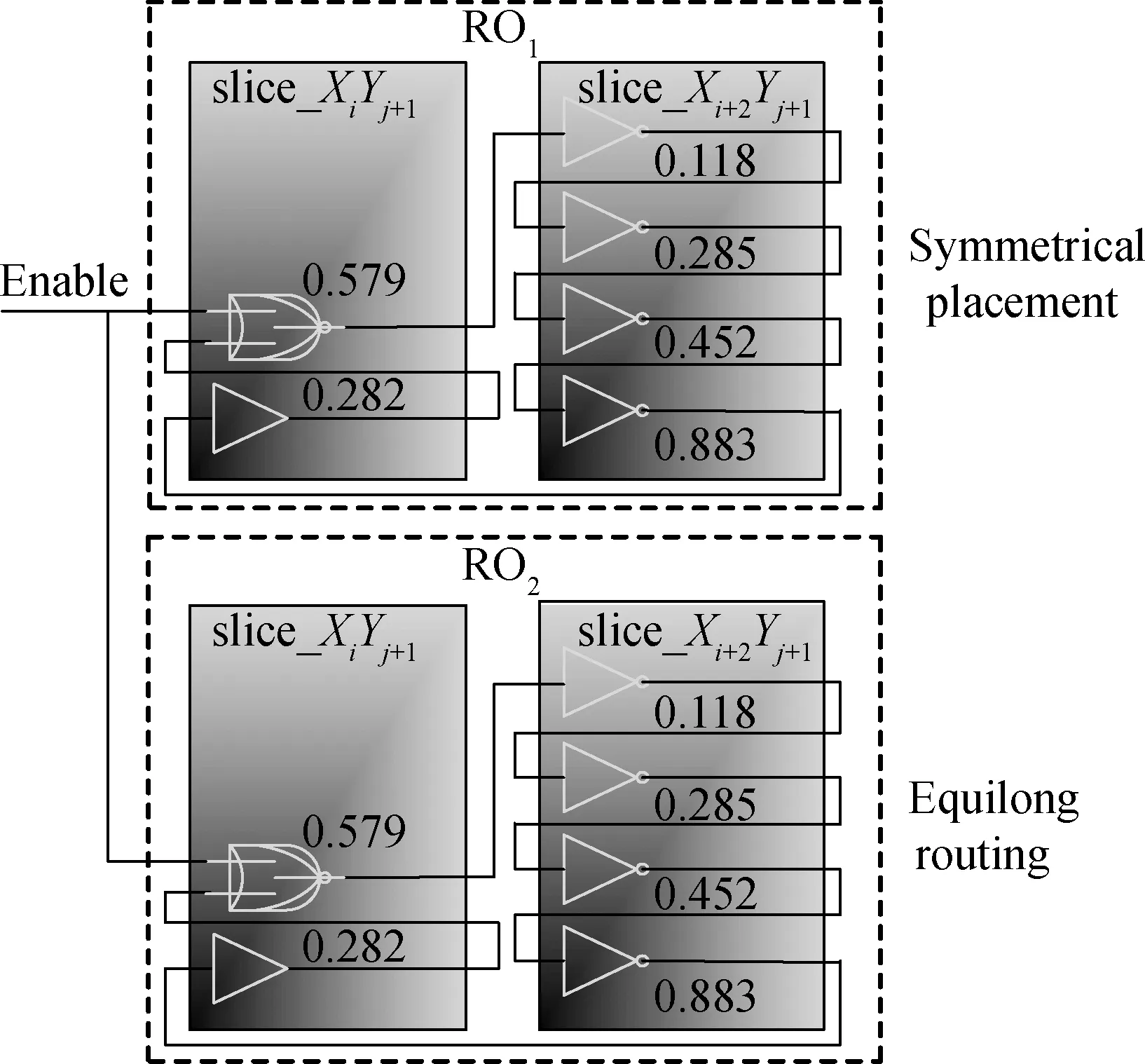
Fig.2 Estimated delays between gates and interconnections (unit: ns)

Fig.3 Hard macro with local routing for four inverters (partial structure of RO)in a symmetrical slice
2.3 Surrounding logic design
In this paper, we present an effective reliability test methodology, by taking full advantage of surrounding logic circuits, to discard unsuitable slices, i.e., units which make PUF unstable after mapping into cells.First, we instantiate an array of original 128 PUFs with the hard macro implemented on the FPGA hardware resource.Meanwhile, the surrounding slices of original PUFs are manually disabled by using relative location constraints to obtain the original PUFs without interference.Then, the original 128-bit PUFs reliability tests are performed under a wide range of operating conditions.
As shown in the black border in Fig.4, we can first implement 16-bit PUFs on the FPGA.Surrounding logic circuits with various complexity are applied to interfere with the 16-bit PUF circuits, and then the bits which make PUF circuits unstable (the bit-flipping bits)are discarded.There are two cases where surrounding logic circuit can act as a disturbance source, which are analyzed and discussed as follows.

Fig.4 Position distribution of the surrounding circuits
In the first case, we design a simple surrounding logic circuit, which is composed of 360 ring oscillators.In other words, 36 ring oscillators which are distributed close to the 16 PUFs are used as interference circuits.Their position distribution is shown in Fig.4.Each ring oscillator consists of four inverters and an NAND gate, and the oscillation frequency of the ring oscillator is about 156 MHz.After discarding some of the unreliable slices by adding a surrounding logic circuit, we randomly extract 128-bit PUFs from the remaining relatively reliable PUFs and test their reliability.In the second case, we change the oscillation frequency of the ring oscillator and increase the complexity of the surrounding logic circuit.Here, the complex logic interference is from the 16-bit PUFs added with an extra 32 oscillators, and then the oscillation frequency of the ring oscillator is changed into about 215 MHz.More slices were discarded due to unreliability among the original PUFs.Finally, we randomly extract 128-bit PUFs from the remaining relatively reliable PUFs and test their reliability again.
3 Experimental Results and Analysis
To demonstrate the positive effects of the presented strategies on the quality of RO-PUFs, we first implemented 160 PUFs on the FPGA hardware resource, and then added surrounding logic near the 160 PUF instances and discarded these unreliable PUFs with bit-flipping.
As shown in Tab.1, it reflects clear results after interference by simple and complex surrounding logic.We can find that after being interfered with by performing simple logic circuit, eight PUFs among them are discarded due to unreliability, and then we continue to add more complex surrounding circuits close to the remaining 152 PUF circuits.The data shows that other six unreliable PUFs have been found.
Tab.1RO-PUF quality results after interference by simple and complex surrounding logic

InterferencetypeOriginalPUFsizeUnreliablePUFsRemainingPUFsExtractedPUFsizeSimpleinterference1608152128Complexinterference1526146128
3.1 Uniqueness
We used our in-house data to validate the uniqueness and reliability of our approach.The PUFs are changed from 0 to 120 ℃ and the core voltage from 0.85 to 1.2 V, so that we can determine the percentage of flip in PUF response bit-streams under environmental variations.Fig.5 shows the histograms of the inter-chip HD for our 8RO-PUF outputs under a normal temperature of 20 ℃.The mean Hamming distance of each histogram is 49.78%.Experimental results show that our PUF has near-ideal uniqueness.

Fig.5 Hard uniqueness profile under different FPGA configuration logic blocks and chips
3.2 Reliability
3.2.1Reliability of original PUFs
To evaluate the reliability of PUFs without any surrounding logic circuits, the intra-chip HD is defined as the Hamming distance between the response sequences when realizing all sample data on the same chip under different operating conditions (Temperature varies from 0 to 120 ℃ and voltage changes from 0.85 to 1.2 V).Here, the core supply voltage is 1 V.As can be seen in Fig.6, the mean value of the intra-chip variation in the implemented original RO-PUFs with 128-bit IDs is equal to 5.77% (PUF reliability is 94.23%), meaning that the average intra-chip Hamming distance (Dintra)is less than 7.4 bits from the 128-bit IDs.It also indicates that the original PUFs without any surrounding logic circuits have relatively low reliability.
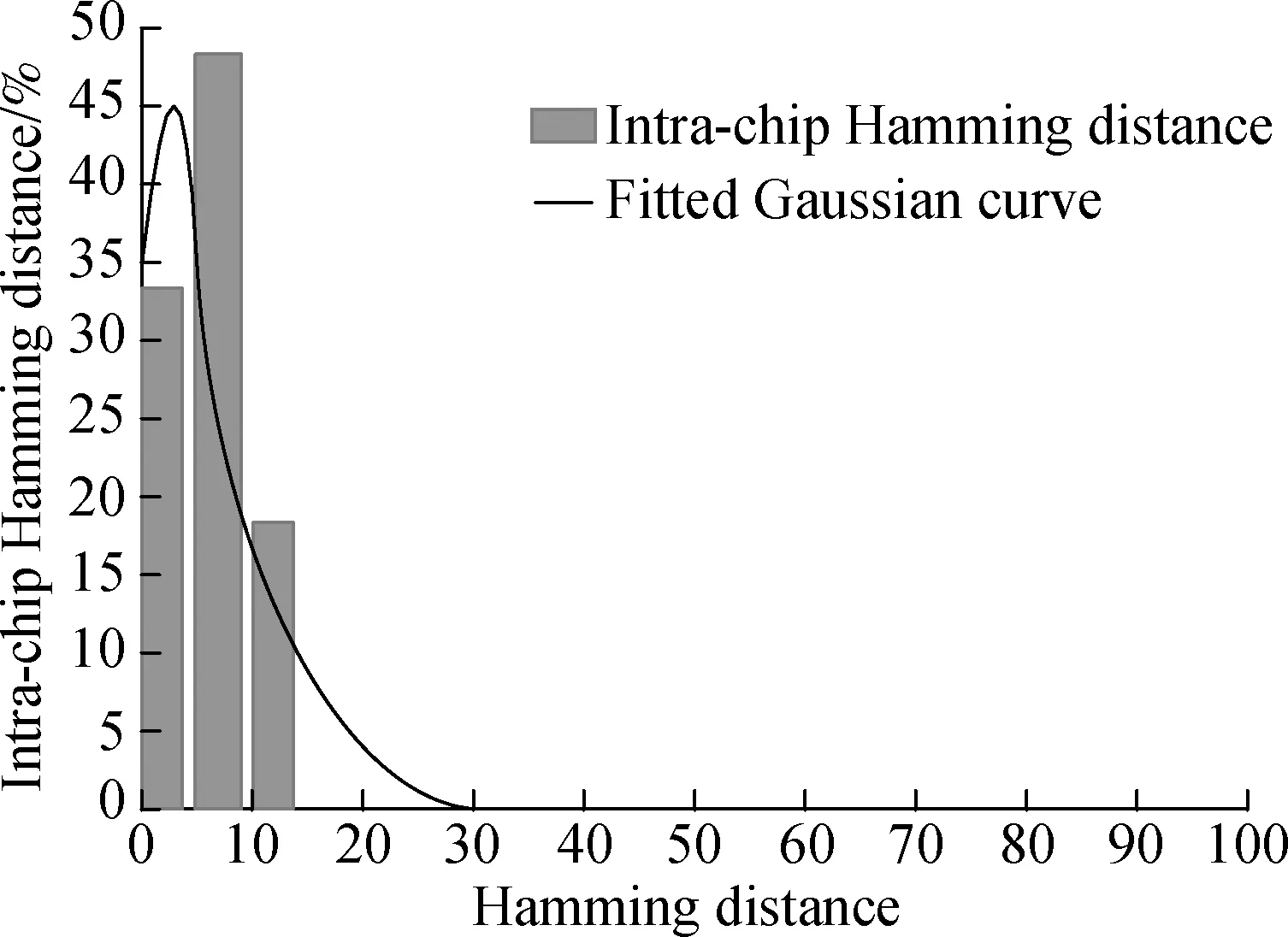
Fig.6 Reliability under voltage and temperature variations for RO-PUF
3.2.2Reliability test after processing
After adding simple surrounding logic circuits, 8-bit PUFs are discarded due to unreliability.Fig.7(a)shows the reliability testing results of 128 PUFs which are extracted randomly from the remaining relatively reliable 152-bit PUFs.The mean value of the intra-chip variation in generated 128-bit IDs is equal to 3.69%, meaning that there is only 3.69% unreliable bits occupying the total instantiated PUFs (PUF reliability is 96.31%).
After adding complex surrounding logic, more 6-bit PUFs are discarded due to unreliability from the 152-bit PUFs.Fig.7(b)shows the reliability testing result of 128 PUFs which are extracted randomly from the remaining relatively reliable 146-bit PUFs.We find that the mean value of the intra-chip variation in generated 128-bit IDs is equal to 2.00%, meaning that the average intra-chip Hamming distance is less than 2.6 bits in generated 128-bit IDs (reliability probability is 98.00%).It also indicates that our proposed methodology can effectively improve PUF reliability when taking surrounding logic into account.
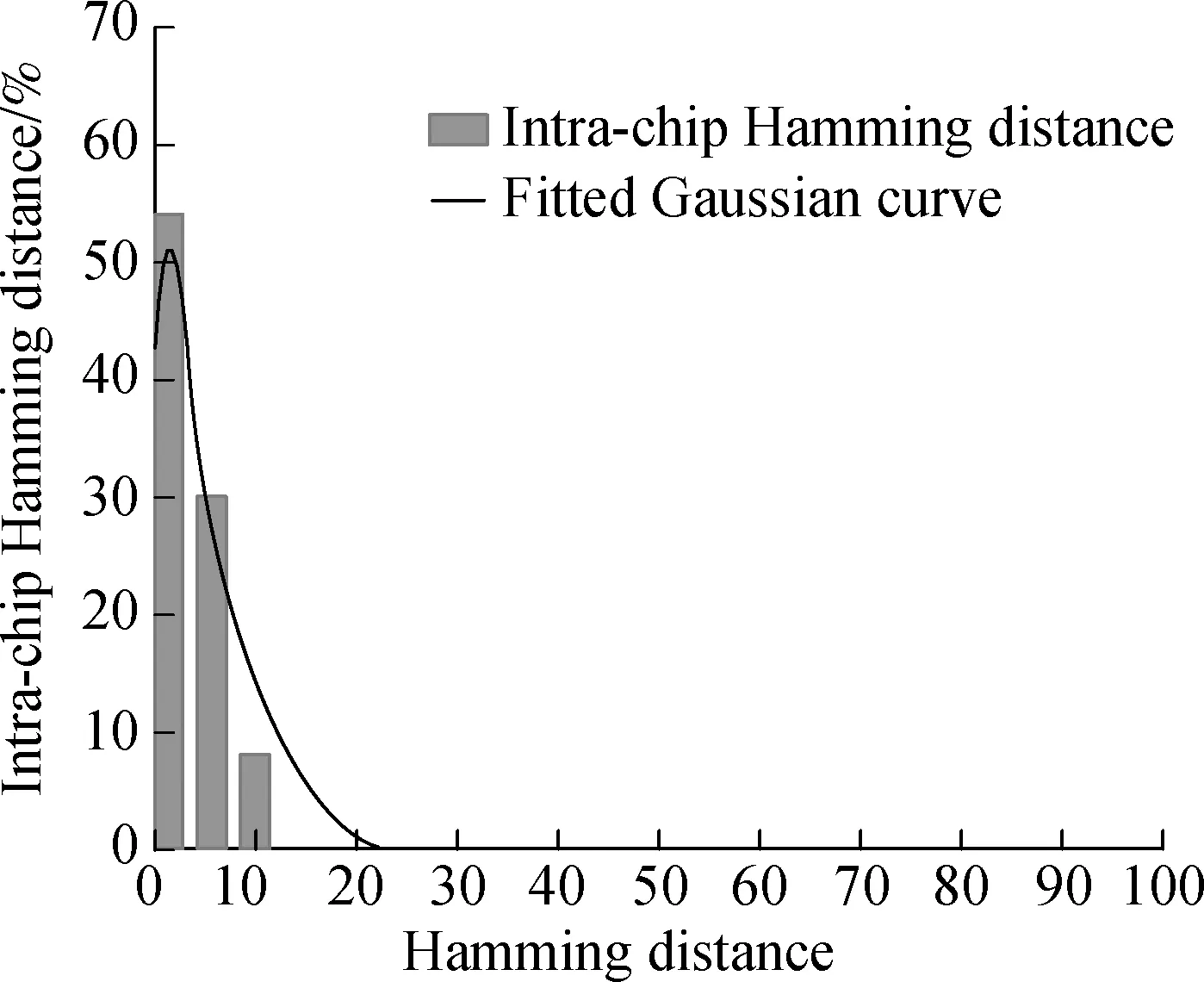
(a)
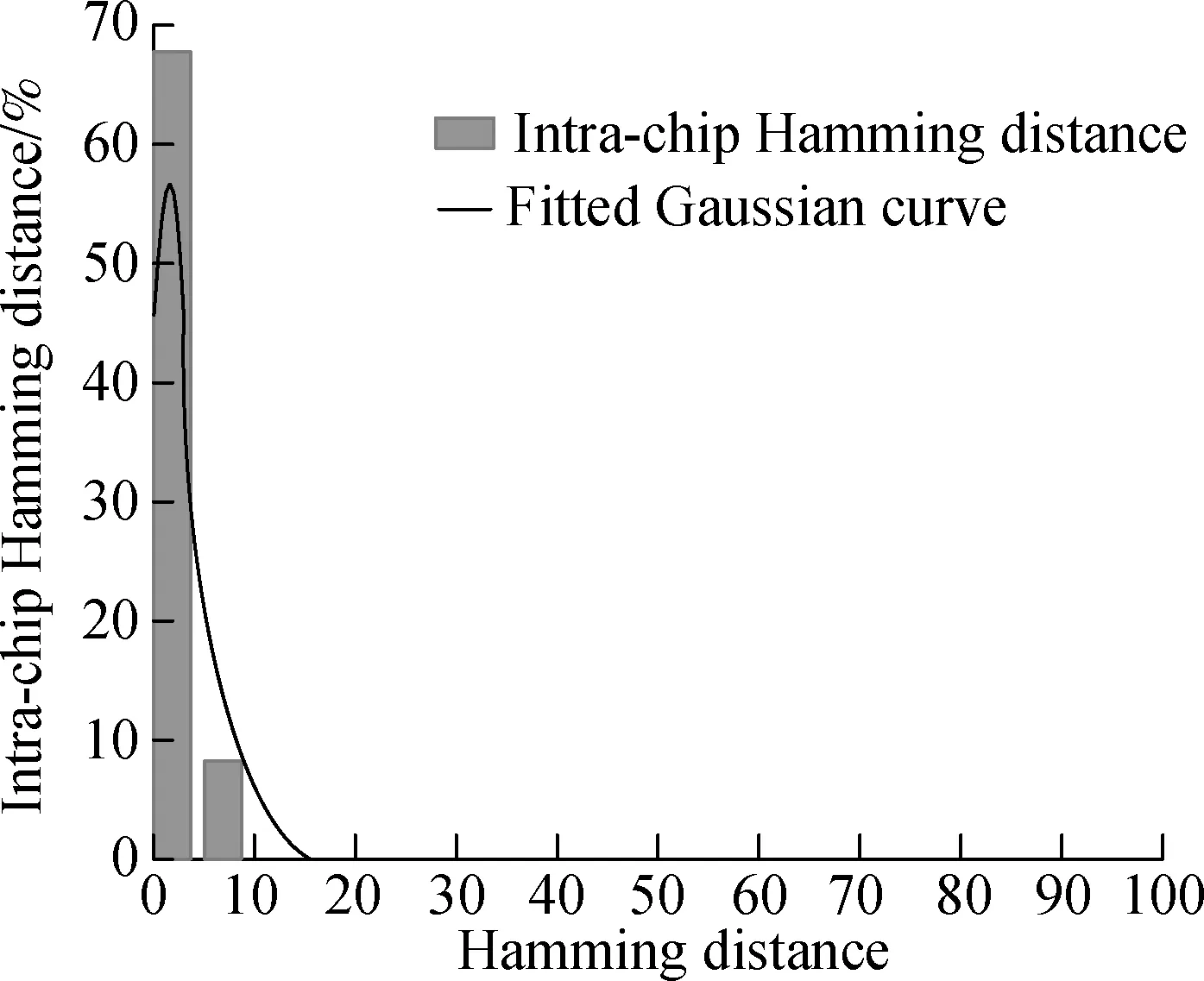
(b)
Fig.7Reliability result.(a)Simple interference; (b)Complex interference
3.3 Randomness
The NIST statistical test suite established for evaluating random number generators is used to prove PUF randomness.Tab.2 gives the detailed test results, from which we conclude that our proposed PUF passes the randomness test and acquires good randomness.In addition, this resource overhead used in the PUF implementation in this paper is analyzed.The counters used to implement 128 PUFs take up 4 096 LUTs, accounting for 2.7% of the total resources and the flip flops used 3 840, accounting for 2.5% of the total resources.The logic gates for 128 pairs of ROs occupy 1 536 LUTs, accounting for 1% of the total resources.In short, the hardware resources used in this paper are relatively small compared to other methods.
Tab.2Measured NIST test suite results of ten chips under normal conditions (20 ℃,1 V)

ParametersPvalueFrequency0.574000FFT0.561658Linearcomplexity0.320837Runs0.574000Blockfrequency0.574000Cumulativsum(1)0.334146Cumulativsum(2)0.574000Longestruns0.106882Approximateentropy0.999878NonoverlappingtemplatePassUniversalPassRandomexcursionsPassRandomexcursionsvariantPass
3.4 Quality improvement analysis
To validate the positive effect of surrounding logic on the circuit delay, a certification experiment was carried out.As the impact of temperature on PUF is very small relative to voltage[14], we focus on the voltage change on PUF in this paper, and then try to find the environmental changes.For example, the voltage increasing from 0.85 to 1.2 V causes a higher level of noise in FPGA’s PUF response.Fig.8 shows the total unstable bits of 128 RO-PUF responses under different supply voltages.The golden PUF line represents the unreliable bits of the original 128 RO-PUF responses without added surrounding logic.Case 1 and Case 2 in Fig.8 represent the unreliable bits of the 128 RO-PUF responses which are added to by a simple and complex surrounding logic, respectively.Apparently, the number of unreliable PUFs is significantly reduced.This indicates that the PUF reliability has been greatly improved, so it has a higher robustness against a change in the external environment.This can be explained as follows: The temperature or voltage variation produced by the surrounding circuit activity results in changes in the electrical parameters, and also affects the speed of digital signals.As a consequence, the entire power supply voltage of PUFs is affected by the surrounding logic activity.

Fig.8 Effect of voltage on RO-PUF
The characterization metrics comparison for related works of PUFs is shown in Tab.3.In our work, in order to test the PUF randomness, 128-bit PUF-bit-streams are implemented in ten Xilinx Virtex-6 FPGAs.The temperature and voltage variations caused by the surrounding circuit activity result in changes in the power supply voltage of PUFs.By taking full advantage of surrounding logic circuit, the uniqueness and reliability reached 49.78% and 98.00%, respectively, under different temperatures (0 to 120 ℃)and voltages (0.85 to 1.2 V).Although the reliability of PUF in Ref.[9] is 0.45% higher than our results (see Tab.3), our earlier research shows that the influence of voltage on circuit delay is much greater that of temperature[14].Therefore, based on the voltage changes of ±2% from 1.2 V nominal supply reported in Ref.[9], we increased its voltage changes by more than 13%, which improved the reproduction ability of the PUF against environmental variations.
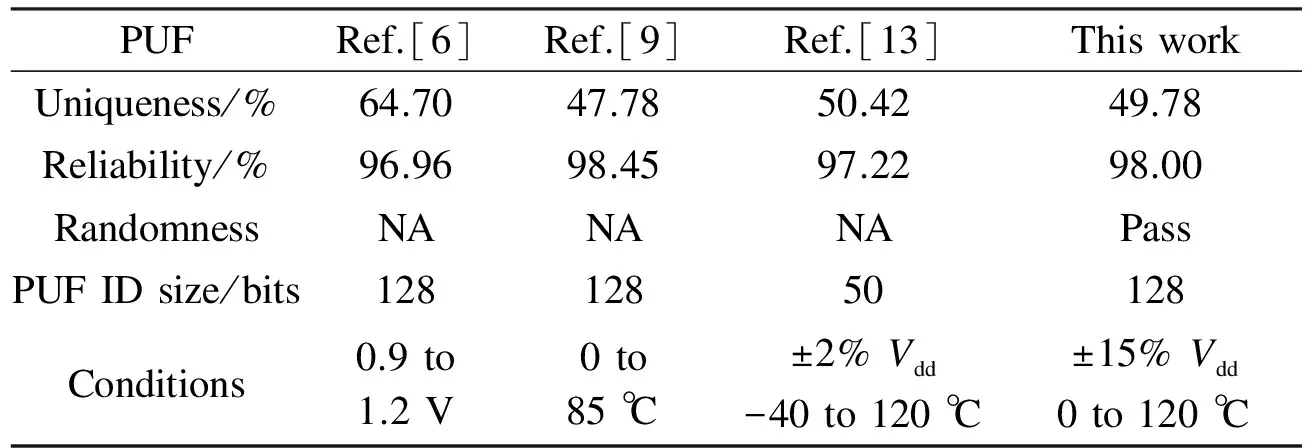
Tab.3 Comparison of the characterization metrics of PUFs
Since surrounding logic activity has a significant effect on the delay of the circuit, in order to improve PUF reliability, the bit flipping rate of the PUF response is reduced.This is achieved by identifying and discarding the unsuitable slices which makes PUF output unstable.Experimental results show that PUF reliability is increased from 94% to 98%, leading to robustness improvement against environmental variations.
4 Conclusion
PUF reliability is seriously unstable as the fluctuations of environmental factors can make it difficult to reproduce identical output.In order to improve PUF reliability, we propose an effective stability test scheme, through which reliable slices and unreliable slices are distinguished.After that, by mapping PUF cells to reliable slices, PUF reliability can be effectively improved.The ring oscillator with multiple complexity and multiple frequencies can identify different unstable slices.The higher the complexity, the more unstable slices are detected.The proposed design has a lower hardware complexity than previous designs.Experimental results show that the proposed PUF has better PUF properties in terms of uniqueness and robustness.Moreover, it is shown that the proposed design is also robust with respect to process, voltage, and temperature variations.
[1]Gassend B, Clarke D, van Dijk M, et al.Silicon physical random functions[C]//Proceedingsofthe9thACMConferenceonComputerandCommunicationsSecurity.Washington, DC, USA, 2002: 148-160.DOI:10.1145/586131.586132.
[2]Suh G E, Devadas S.Physical unclonable functions for device authentication and secret key generation[C]//2007 44thACM/IEEEDesignAutomationConference.San Diego, CA, USA, 2007: 9-14.DOI:10.1109/dac.2007.375043.
[3]Herder C, Yu M D, Koushanfar F, et al.Physical unclonable functions and applications: A tutorial[J].ProceedingsoftheIEEE, 2014,102(8): 1126-1141.DOI:10.1109/jproc.2014.2320516.
[4]Delvaux J, Gu D, Schellekens D, et al.Helper data algorithms for PUF-based key generation: Overview and analysis[J].IEEETransactionsonComputer-AidedDesignofIntegratedCircuitsandSystems, 2015,34(6): 889-902.
[5]Zhang J L, Lin Y P, Lyu Y Q, et al.A PUF-FSM binding scheme for FPGA IP protection and pay-per-device licensing[J].IEEETransactionsonInformationForensicsandSecurity, 2017,10(6): 1137-1150.
[6]Su Y, Holleman J, Otis B.A 1.6 pJ/bit 96% stable chip-ID generating circuit using process variations [C]//IEEEInternationalSolid-StateCircuitsConference.San Francisco, CA, USA, 2007: 406-407.DOI:10.1109/isscc.2007.373466.
[7]Khan S, Hamdioui S, Kukner H, et al.Incorporating parameter variations in BTI impact on nano-scale logical gates analysis [C]//IEEEInternationalSymposiumonDefectandFaultToleranceVLSIandNanotechnologySystems.Austin, Texas, USA, 2012: 158-163.DOI:10.1109/dft.2012.6378217.
[8]Kastensmidt F L, Tonfat J, Both T, et al.Voltage scaling and aging effects on soft error rate in SRAM-based FPGAs[J].MicroelectronicsReliability, 2014,54(9): 2344-2348.DOI:10.1016/j.microrel.2014.07.100.
[9]Freijedo J F, Semião J, Rodriguez-Andina J J, et al.Modeling the effect of process, power-supply voltage and temperature variations on the timing response of nanometer digital circuits[J].JournalofElectronicTesting, 2012,28(4): 421-434.DOI:10.1007/s10836-012-5297-0.
[10]Stanciu A, Cirstea M N, Moldoveanu F D.Analysis and evaluation of PUF-based SoC designs for security applications[J].IEEETransactionsonIndustrialElectronics, 2016,63(9): 5699-5708.DOI:10.1109/tie.2016.2570720.
[11]Tao S, Dubrova E.Ultra-energy-efficient temperature-stable physical unclonable function in 65 nm CMOS[J].ElectronicsLetters, 2016,52(10): 805-806.DOI:10.1049/el.2016.0292.
[12]Maiti A, Schaumont P.Improving the quality of a physical unclonable function using configurable ring oscillators [C]//InternationalConferenceonFieldProgrammableLogicandApplications.Prague, Czech Republic, 2009: 703-707.DOI:10.1109/fpl.2009.5272361.
[13]Cao Y, Zhang L, Chang C-H, et al.A low-power hybrid RO PUF with improved thermal stability for lightweight applications [J].IEEETransactionsonComputer-AidedDesignofIntegratedCircuitsandSystems, 2015,34(7): 1143-1147.
[14]Liang H G, Xu X M, Huang Z F, et al.A methodology for characterization of SET propagation in SRAM-based FPGAs[J].IEEETransactionsonNuclearScience, 2016,63(6): 2985-2992.DOI:10.1109/tns.2016.2620165.
杂志排行
Journal of Southeast University(English Edition)的其它文章
- Design of a 12-Gbit/s CMOS DNFFCG differential transimpedance amplifier
- A hybrid algorithm based on ILP and genetic algorithm for time-aware test case prioritization
- Nonlinear identification and characterization of structural joints based on vibration transmissibility
- Molecular dynamics simulations of strain-dependent thermal conductivity of single-layer black phosphorus
- Efficient and reliable road modeling for digital maps based on cardinal spline
- Modeling and control of MR damper considering trapped air effect
